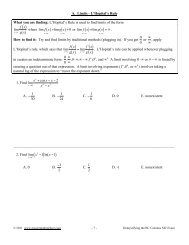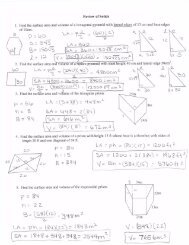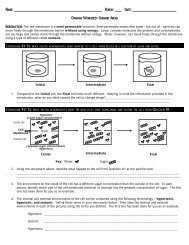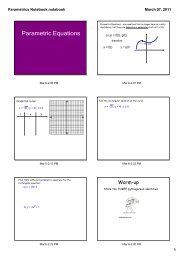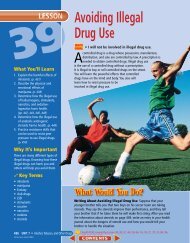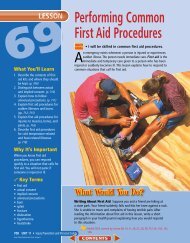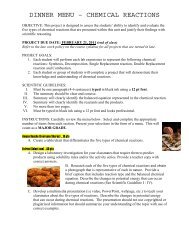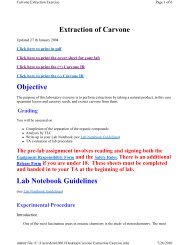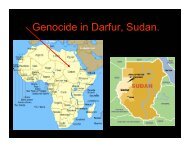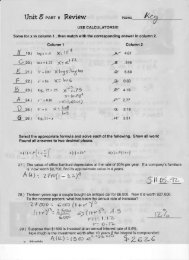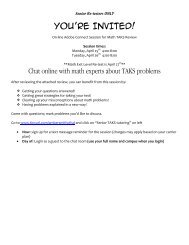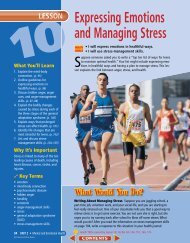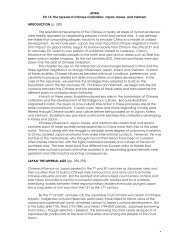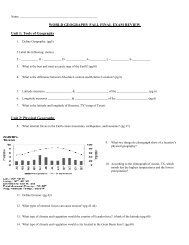Paper-and-Glue Unit Cell Models W
Paper-and-Glue Unit Cell Models W
Paper-and-Glue Unit Cell Models W
Create successful ePaper yourself
Turn your PDF publications into a flip-book with our unique Google optimized e-Paper software.
Figure 6. Face-centered <strong>and</strong> simple cubic unit cell paper-<strong>and</strong>-glue<br />
models.<br />
with them at the end of the class to use as they study the<br />
lecture material. We also recommend that they use the models<br />
when they study crystalline structures in the laboratory<br />
component of the course.<br />
The general chemistry students at our university build<br />
various solids in the lab using the ICE model kit (7). Based<br />
on student responses in their lab reports, the investigation is<br />
moderately successful; however, the students still have difficulty<br />
visually “slicing” the spheres in the kit in order to identify<br />
the type of unit cell in each of the structures. Students<br />
report that the paper models from lecture help them to identify<br />
unit cells <strong>and</strong> visualize them when looking at a model of<br />
a crystalline solid. We have also used animations designed<br />
by members of our research group to show how atoms in<br />
crystal structures are “sliced” into unit cells.<br />
Assembling the unit cell models to form a model of a<br />
crystal enables the students to participate in a large group<br />
activity. They also have a personal h<strong>and</strong>s-on model to examine<br />
before, during, <strong>and</strong> after lecture as well as a threedimensional<br />
model showing the arrangement of atoms in<br />
unit cells.<br />
Acknowledgments<br />
We thank Rachel Morgan of Arizona State University<br />
<strong>and</strong> Michael Laing of the University of Natal for suggestions<br />
regarding the dissectable version of the unit cell for the bodycentered<br />
cubic unit cell.<br />
Chemistry for Everyone<br />
Figure 7. Model of crystalline solid structure built from face-centered<br />
cubic paper-<strong>and</strong>-glue unit cells.<br />
This work was supported in part by the National Science<br />
Foundation under grant no. DUE 9453610 <strong>and</strong> the<br />
U. S. Department of Education under grant no. OPE<br />
P336B990064. Opinions, findings, <strong>and</strong> conclusions or recommendations<br />
expressed in this publication are those of the<br />
authors <strong>and</strong> do not necessarily reflect the views of the National<br />
Science Foundation or the Department of Education.<br />
W Supplemental Material<br />
Full-sized versions of the templates, which can be printed<br />
on 8.5-in. × 11-in. paper <strong>and</strong> result in cube sides of about<br />
6 cm, are available on JCE Online.<br />
Literature Cited<br />
1. Kasahara, K. Origami Omnibus; Japan Publications, Inc.: Tokyo,<br />
1988.<br />
2. Hanson, R. M. Molecular Origami; University Science Books:<br />
California, 1996.<br />
3. Yamana, S. J. Chem. Educ. 1988, 65, 1074.<br />
4. Yamana, S. J. Chem. Educ. 1987, 64, 1033.<br />
5. Yamana, S. J. Chem. Educ. 1987, 6, 1040.<br />
6. Olsen, R.; Tobiason, F. J. Chem. Educ. 1975, 52, 509.<br />
7. Mayer, L.; Lisensky, G. Solid State Model Kit, version 4.0, ICE<br />
Publication No. 94-004; Institute for Chemical Education:<br />
Madison, Wisconsin, 1994.<br />
8. Laing, M. J. Chem. Educ. 1997, 74, 795.<br />
JChemEd.chem.wisc.edu • Vol. 80 No. 2 February 2003 • Journal of Chemical Education 159



